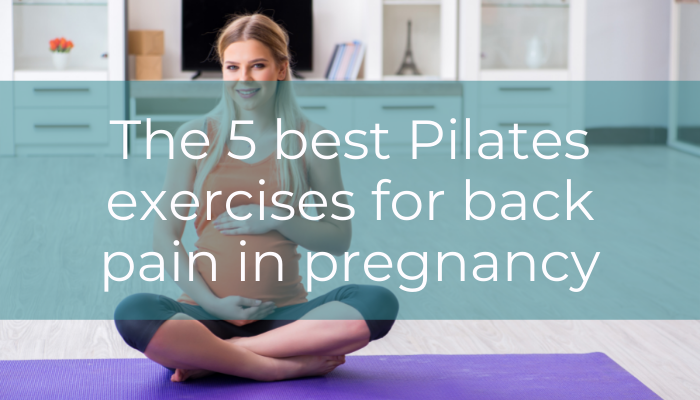The 5 best exercises for lower back pain in pregnancy

Struggling with back pain in pregnancy? Need to know what exercises to do?
Having a baby can be joyful and daunting at the same time.
The thrills and spills of every trimester bring new challenges and new opportunities to experience the delight of motherhood.
But with all of the joys that come with pregnancy, there can also be a range of pregnancy-related physical changes and symptoms that can be tricky to overcome.
One of the most common complaints is back pain in pregnancy.
This article gives you 5 pilates-based exercises to help you ease your discomfort and feel more mobile so you can get on with your day with less pain.
How pilates exercises help for back pain in pregnancy
Clinical Pilates can help you:
- Prevent pain
- Maintain strength
- Reduce stress
- Decrease your risk of developing diastasis recti (tummy gap) and pelvic floor problems
Best of all, it’s fun and shown to improve the pregnancy experience in women too!
These low-impact exercises (no bounding or jumping) offer significant benefits, including enhancing your breathing, and helping you build and maintain strength throughout your pregnancy.
This can help prepare your body for carrying your baby and support your recovery after birth, regardless of whether you have a vaginal delivery or caesarean section.
More upsides to Pilates are that you can do it with or without equipment and it’s very versatile. So you can adapt it to your needs and abilities as you progress through your recovery.
At our clinics, we offer clinical pilates sessions tailored to your condition using props when necessary, such at the Pilates ring and Swiss ball.
Although we may use props to enhance the impact of the exercises in clinic, we also show you how to do your exercises at home without any equipment. So you can practice them as regularly as you like.
How to do these pregnancy exercises safely when you have back pain
In the video below you’ll see the top 5 exercises we recommend for pregnant patients experiencing back pain.
Before you do the exercises, it’s important to keep these precautions in mind so you don’t worsen your pain or cause further injury:
- Ensure you have enough floorspace and room around you for performing the exercises.
- Listen to your body; don’t push through pain. If something doesn’t feel right, take a break, or skip the exercise.
- Try not to look at the screen while you’re doing the exercises. It can affect your balance and may hurt your neck. Instead, watch the demonstration then pause it. Do the exercise, then go back and continue to the next one.
Tips for getting these pregnancy back pain exercises right (and why they work)
Exercise 1: Lateral breathing
Lateral breathing will:
- Enhance your joint position sense (proprioception)
- Increase your lung capacity (how much air your lungs can hold)
- Lengthen your spine
- Condition your deep abdominal muscles (core)
Exercise 2: Thoracic rotation
Thoracic rotation is key to reducing lower back pain because it helps stabilise and strengthen your lower back muscles, which take on more and more load as your baby grows.
The trick is keeping your waist and hips facing forward, while your ribs and shoulders rotate around your central axis.
Exercise 3: Quadruped hip hinge
A crucial skill to master to prevent lower back pain and control it when it flares, is being able to move your hips without moving your pelvis.
In pregnancy, your pelvic ligaments can become more mobile as a result of hormonal and weight distribution changes. This can cause your pelvis to lose some of its support functions and resulting in lower back pain.
This exercise helps add extra support in your pelvis while moving your hips.
Exercise 4: Quadruped lateral rotation
Similarly to exercise 2, here we focus on opening the chest, whilst keeping the lower back stable.
Notice the difference between stabilising the pelvis here and during exercise 2: Which one did you find easier?
Exercise 5: Semi supine pelvic rotation
This is the most challenging exercise (that’s why it comes last).
As you shift your weight from the left to the right side of your pelvis, focus on maintaining a neutral curve in your back.
Imagine your tailbone always being the heaviest point, with a sense of lightness in the lower back.
Keeping the two sides of your pelvis aligned (without dropping one half during the rotation) helps to strengthen the pelvic ligaments and balances out the pregnancy-related changes mentioned above.
Conclusion
These exercises will help you enjoy your pregnancy more by reducing your back pain. They work by improving your posture and keeping your pelvic floor and deep abdominal muscles strong and functional well.
Things to remember:
- Make sure to practice these exercises regularly so your muscles remain balanced throughout your pregnancy.
- Exercises should feel comfortable and no movement should be too difficult – always modify where necessary!
- If you still experience pain or the exercises aren’t getting easier after a few weeks, you may need a hands-on physiotherapy assessment and individual treatment to get to the root of your problem and heal it.
If you’re experiencing back pain after pregnancy, our Mummy MOT sessions can help you identify the causes.
Need some help getting started or progressing with these exercises?
Prefer to see a specialist physiotherapist in person to assess and treat your pain properly?
Book an appointment with us today and we’ll help you get back on your feet as soon as possible and feeling like yourself again in no time.
